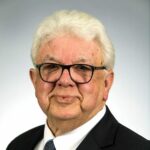How we dealt with a pandemic – a century ago
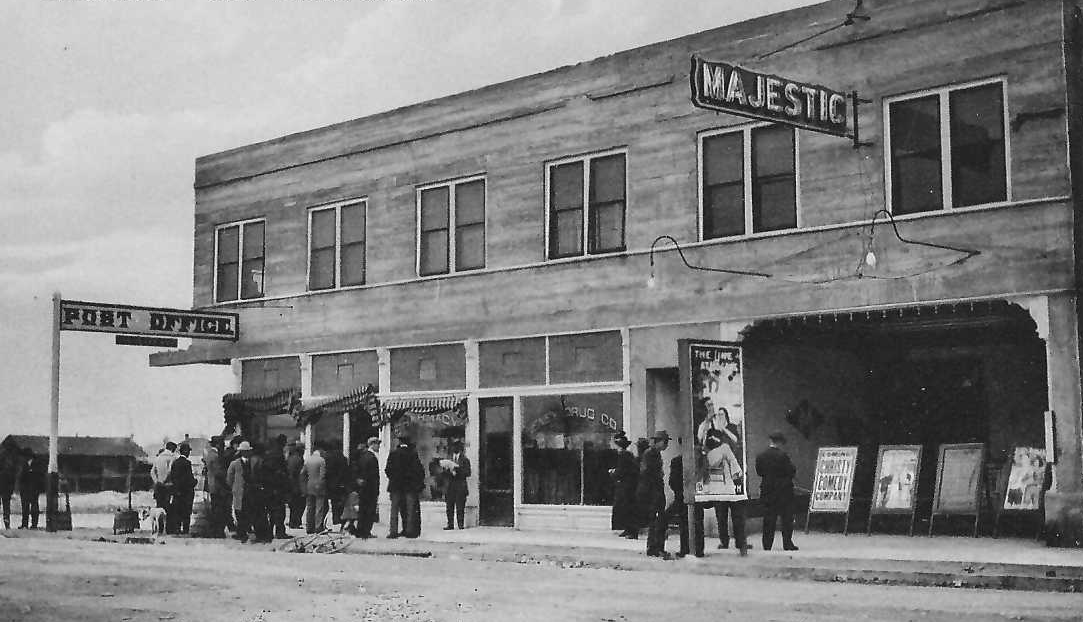
Editor’s note: This is the first of a two-part piece. The second part will be published Monday, June 29. Additional notes on this topic, assembled by longtime Nevada journalist and historian Bob Stoldal, who now serves as chairman of the board of The Nevada Independent, were published in April. As the coronavirus pandemic plays out in Nevada and the nation, these windows into the last worldwide contagion are eerily familiar.
It promised to be the biggest show in town.
Hundreds of Las Vegans bought tickets to see several of the city’s most eminent residents perform in blackface.
Participants were to include the county’s Chief Health Officer, Dr. Royce W. Martin; his partner, Dr. Silas Lewis; Gertrude Woodard, the wife of Sheriff J. W. Woodard; and Alta Ham, wife of the city’s top attorney, Artemus Ham.
The minstrel show was being staged by the Las Vegas Elks on a Tuesday evening, September 24, 1918. The city’s two weekly newspapers, the Las Vegas Age and the Clark County Review, promoted the event with page one stories.
Charles P. Squires, publisher and editor of the Age, promised that the local Elks would come up with “A dashing, smashing, laughter making Minstrel Show” and that all the “characters of black-face joyousness will be there in person.”
Charles Corkhill, publisher and editor of the Review, wrote that the Elks were promising “Really sure enough minstrels” with “plenty of real jokes” and songs like “How’d you like to be my Daddy.”
The event was to benefit the Salvation Army War Fund.
World War I was in its fourth year. By the fall of 1918, the U.S. and its allies in Europe appeared to be winning.
At the same time, reports began piling up about a flu that was killing military personnel in Europe and in staging areas in the United States.
Quoting government sources, Los Angeles and Salt Lake newspapers distributed in Las Vegas published often-confusing government reports on what was being labeled the “Spanish Flu.”
Because it was wartime and an epidemic could have a serious impact on morale, the government initially kept the spread of the virus within the military quiet.
The war, the sickness and the upcoming presidential and statewide elections in Nevada for the next governor and Clark County’s next sheriff were the primary topics of discussion in Las Vegas.
Also on the ballot was a question as to whether the sale of alcohol in Nevada should be banned. Fifteen other states had already banned sales. (The federal government had not yet enacted a prohibition.)
About 77,000 people lived in Nevada in 1918; more than 20,000 of them resided in Reno, the state’s largest city.
Clark County’s population was close to 4,600 residents. That number included the estimated 2,200 residents of the close-knit community of Las Vegas.

In the fall of that year, trains traveling through Southern Nevada were packed with military personnel. And during the brief stop in Las Vegas, up to 100 young men would often jump off the train and head for the saloons.
The Overland Hotel bar, on the northeast corner of Main and Fremont – across the street from the railroad depot – was one of their favorites.
Those unable to get a drink at the hotels spread through town finding a drink in the town’s 12 licensed liquor establishments.
Too often, trouble brewed, and law enforcement would round up and escort the soldiers back to the train.
Annoyed by the barroom brawls, Las Vegas Mayor W. E. Hawkins ultimately issued an order that all saloons had to close while troop trains were in town.
And there was a growing concern that the trains, which were controlled by the U.S. government during the war, were carrying not just troops, but the flu virus to Las Vegas.
The leading trade journal, “Railway Age,” urged the government to avoid crowding the trains “as much as possible.” It also advised that “Insistence on open windows and ventilators is a positive necessity.
“Notices should be placed in cars that anyone having to sneeze or cough should do so in his handkerchief. Spitting in passenger coaches is still seen and is a particular evil in smoking cars. It is not only a most obnoxious habit, but under present conditions, it is positively dangerous. Trainmen should be instructed to demonstrate with those who persist in the habit.”
***
As soldiers traveled through Las Vegas toward war, many residents each summer headed for the cooler climes in southern California or Utah – only to return in the fall when unpleasant summertime temperatures would cool off and schooling resumed.
Among them was William “Bill” Pike, the operator and part owner of the Majestic Theatre. The theatre was closed during his two-month summer absence. Besides, the theater was just too hot to draw a crowd.
Air conditioning of large buildings was just being developed in 1918 and had not yet come to Las Vegas. At the time, a fan blowing through a wet towel was the state of the art method to cool rooms. Ventilation at the windowless Majestic, in large part, was achieved through opening the doors.
In addition to getting the motion picture side of the operation ready after his summer sojourn, Pike had to prepare for what promised to be the biggest live show of the year.
His partner was Earnest Cragin, who at the time was serving in the submarine service. He would later be elected mayor of Las Vegas.
Among others who fled the Vegas heat was Dr. Martin, who took his wife and two school-age daughters to the beaches of southern California for their summer escape. Before he left on vacation, he purchased a 1905 hotel in downtown Las Vegas. By the end of 1918, he had converted the two-story building into a private hospital.
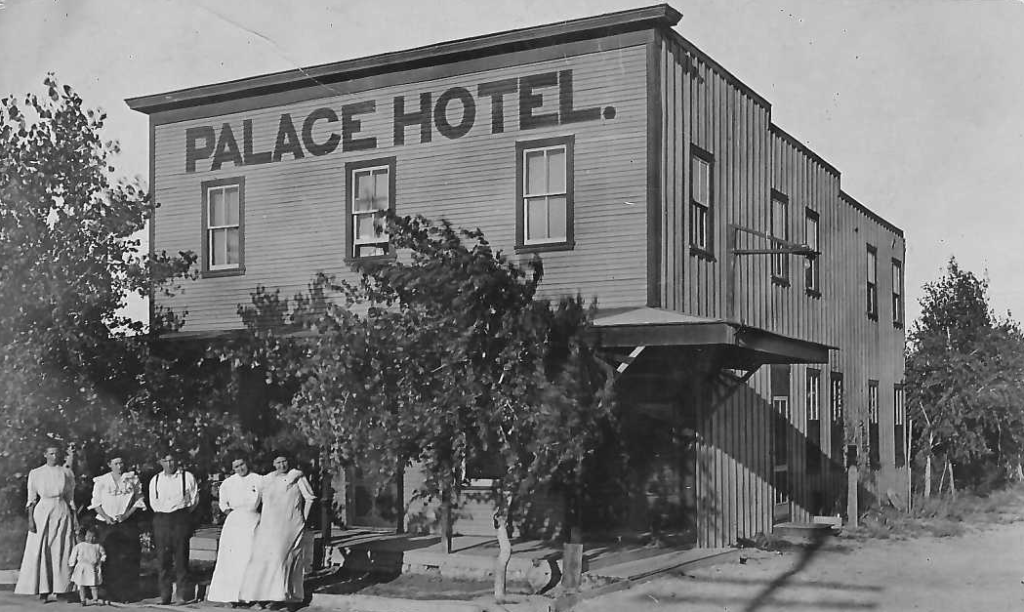
As school was getting ready to resume, the Martin family returned to Las Vegas. The doctor also had to rehearse for his role in the upcoming minstrel show.
During rehearsals, several performers said they were not feeling well, and substitutes were quickly drafted from friends and family. By show time, September 24, the cast — with stand-ins for those who had fallen ill — was ready.
When the curtains opened at the Majestic Theatre, the performers saw a packed house.
The show was a big hit, generating rousing reviews in the town’s two newspapers.
In his Las Vegas Age, Squires wrote: “From the time the curtain revealed the semi-circle of black-face folks, resplendent in their shining satins and silks, until the last note of the finale, there was not a dull moment.”
Over at the Clark County Review, Corkhill wrote, “The show was a hit,” as Dr. Silas Lewis and his “black-face patter and jokes brought down the roof.”
Corkhill said the Elks jammed “as many as could get in the Majestic,” sizing up the audience at “over 400 people” in the 150-seat theatre.
At the time, a few members of the audience complained about the poor ventilation in the auditorium. Squires observed something else: members of the cast were sick. “Several of the principal characters were suffering from the epidemic of influenza,” he wrote.
Indeed, after infecting an estimated one-third of the world’s population and killing at least 50 million people, with about 675,000 in the United States, the worldwide Spanish Flu Pandemic of 1918 had arrived in Las Vegas — and had spread throughout the cast during rehearsals the week of September 15.
Squires reported that among the members of the original cast “too ill to appear” were Sheriff Woodard’s wife and “little Mazie Martin,” Dr. Martin’s daughter.
In September of 1918, it seemed that the Majestic, the city’s only movie theater, was a readymade infection and distribution center. The fast-moving virus slammed at least half the minstrel cast. And within days, it was spreading to their spouses and children.
By the time the city’s weekly newspapers came out on Saturday morning, Sept. 28, the community knew something was wrong.
Seventy-two hours after the Majestic show, and facing a printing deadline Friday night, Squires had talked with local doctors and gathered enough information to publish a three-paragraph story in the Age.
The frightening headline: “INFLUENZA EPIDEMIC PREVALENT IN VEGAS.”
Squires reported, “A number of Vegas people have been suffering from an epidemic of influenza, whether of the notorious ‘Spanish’ type or not being as yet not definitely determined.”
The story listed those who “have suffered severely” from the unknown illness. The list included Mrs. Artemus Ham, along with Dr. Martin, his wife and two daughters.
Another member of the minstrel cast, Mrs. Pembroke, was reported to have “developed a severe case of pneumonia” and was in “critical condition.”
The townsfolk were unsettled and for good reason: The debilitating sickness was spreading quickly through the community.
Within two weeks of the show, 80 cases of influenza were reported in Las Vegas, along with six cases of pneumonia associated with the flu.
One of the afflicted was Harry Edward Davisson, a 30-year-old mechanic who worked at the railroad shops. On Oct. 3, Davisson contacted Dr. Silas Lewis who confirmed the railroad man not only had the flu but maybe pneumonia as well.
The Las Vegas Age was now telling its readers, “The Spanish influenza epidemic which has been sweeping the country has assumed serious proportions in Las Vegas.”
Fear also spread through the community when Squires pointed out that “No serum or other remedy for the disease is known.”
Instructions on ways to slow the spread of the flu — close schools, discontinue all public meetings, and close places of “public amusement” including movie theatres were issued during the first week of October by Dr. Simeon Lemuel Lee, the head of the Nevada Board of Health.
Lee, acting on advice that U.S. Surgeon General Blue had telegraphed around the country, in turn wired all county health officers with the order that all public meetings in Nevada be cancelled, and that schools and “places of public amusement” be closed.
Then, on October 1, 1918, a New York doctor, according to a Los Angeles newspaper, announced the “discovery of a serum” that “preliminary experimentation” showed would “act as a preventive for Spanish influenza.”
The doctor said the preventive serum would be ready for “distribution in small quantities,” adding that he did not claim the treatment would cure the disease.
***
Las Vegas swiftly closed its schools, churches and Sunday school classrooms, and the Majestic locked its doors.
Initially, the town’s small medical community was not entirely ready to declare Las Vegas was in the grips of the Spanish Flu. This medical indecision was reflected in the town’s newspapers, which were publishing conflicting stories.
The Age reported there was an influenza “epidemic” in Las Vegas, while the Review reported “local doctors” said there were “no” cases of the flu.
There was only one direct reference to the flu in the Clark County Review’s Saturday morning, October 5 edition. It was found at the end of a column of 30 local news briefs on the last page of the newspaper.
The first column item informed readers that “Mrs. W. F. Merry has been in Las Vegas the past week visiting Friends.”
The 29th column item said, “An epidemic of Grippe, with more serious complications, has been in process here during the past two weeks. Current reports had the epidemic as Spanish Influenza, but local doctors say there are no cases of the ‘flu’ in Las Vegas at present.”
The newspaper further reported that during the city commission’s “brief session” on October 2, it had passed a resolution requesting that Dr. Martin “take up with the owner of the Majestic Theatre the question of better ventilation for the theatre.”
On October 7, two days later, Harry Edward Davisson, a 30-year-old railroad mechanic, became the first casualty of the Spanish Flu in Las Vegas.
Dr. Lewis wrote on the death certificate that the primary cause of death was “acute cardiac dilatation” with “Lobar Pneumonia” as a “contributing” factor.
Squires reported that Davisson’s death “came as a shock to the community. He had been suffering from pneumonia following an attack of influenza and in spite of all care and every medical aid, he passed away.”
Davisson’s death also came as health authorities reported the number of cases of Spanish Flu in Las Vegas had passed the 50 mark. Many of the cases were complicated as the patients showed signs of pneumonia.
Whether the paper wanted to calm its readers or was simply passing on information from members of the medical community, the October 12 edition of the Clark County Review continued to downplay the disease.
The news had advanced from the last page to the front page of the newspaper a week later, but the threat was still downplayed. The lead paragraph in the page one story claimed the “Spanish influenza” was simply just the “old fashioned grippe.”
By mid-October, health officials reported the number of cases had passed 100 and was growing daily.
A week later, on October 19, a page-one headline in the Las Vegas Age read: “Influenza epidemic on the decline.”
The story said, “There are now only about five new cases a day and the attacks seem generally less severe than the first cases.”
Squires closed by saying, “It is hoped that the epidemic will soon wear itself out.”
The story was more optimistic than factual. The number of Spanish flu cases in Las Vegas, according to public health officials, would jump again.
It did.
By the third week in October, less than a month from the initial outbreak, the number of cases has gone from zero to approximately 140, with several fatalities attributed to it.
Still, with the statewide general election just a few weeks off, political stories and advertisements continued to push the pandemic story off the front pages of the local newspapers.
At the end of October, Gov. Emmett Boyle, his wife, and U. S. Sen. Charles B. Henderson made a final campaign swing through Southern Nevada. After rallies in Tonopah and Goldfield, the campaign train headed south to Las Vegas. They would discover there that indoor rallies were off-limits due to the flu, so candidates turned to walking the streets and shaking individual voters’ hands. Who knew how many were carrying the influenza virus?
The politicians brought with them their positions on the issues of the day, including a ban on the sale of alcohol, and the closing of an 11-year-old, family-owned Las Vegas railroad connection to Northern Nevada.
Government leaders and politicians opposed the closing of the train link, arguing that Las Vegas’ economic foundation was that of a railroad town. The main line through Las Vegas connected Los Angeles and Salt Lake City. The family-owned railroad also connected Las Vegas to the boomtowns of central Nevada.
Both Sen. Henderson and Gov. Boyle were in favor of the booze prohibition, and both initially opposed closing the railroad because of its negative impact on the Las Vegas economy.
That railroad – the Las Vegas Tonopah Railroad – was owned by the family of wealthy Montana Sen. William Clark. The family complained that they had been losing money for years, and were now intent on ripping up the tracks come Oct. 31.
Gov. Emmet Boyle, who arrived in Las Vegas on Oct. 21 – into the eye of an influenza storm – thought twice about his argument to keep the railroad open after receiving telegram from Reno Mayor Frank J. Byington the next evening.
The mayor told the governor that while Reno was taking “drastic measures” to hold the “epidemic down,” the “chief danger to our state is on account of people coming here on trains.”
Byington recommended the governor send “competent people to inspect all trains at state line and have said trains disinfected.”
In addition, Byington advised that “every person who intends stopping off at any point in state receive thorough inspection while on train and put in quarantine if they show signs of disease.”
As far as the travelers who wanted to get off the trains in Nevada and who didn’t show signs of the disease, the Reno mayor said they should be “disinfected and placed under observation.”
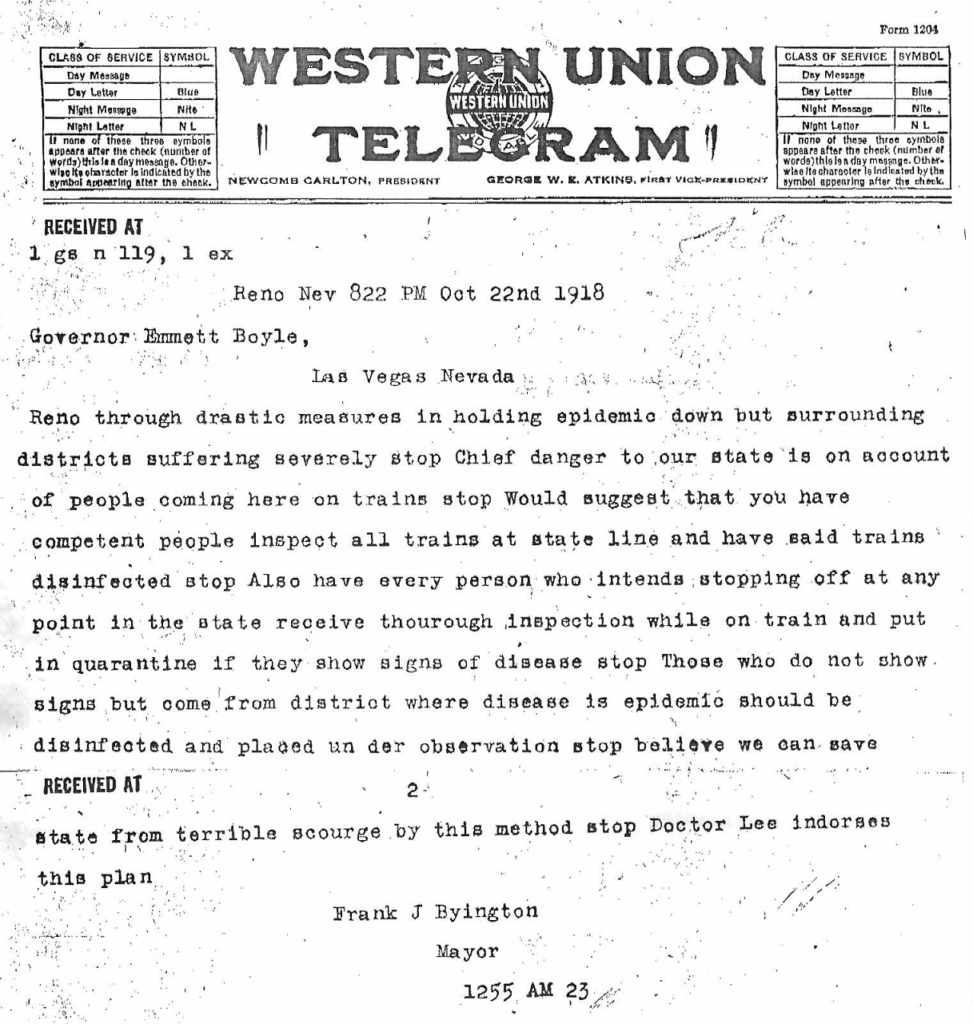
Telegram provided courtesy of the personal collection of Bob Stoldal.
After meeting with Dr. Lee, who endorsed the suggested plan, the mayor also told the governor his train plan could “save the state from a terrible scourge.”
The next morning, October 23, the Gov. Boyle began sending telegrams.
The first was to Dr. Lee. The governor told the state’s chief health officer that the Reno mayor’s idea had his “full approval.”
Boyle told the state health officer to “send names of proper persons” to the state police so they could be deputized.
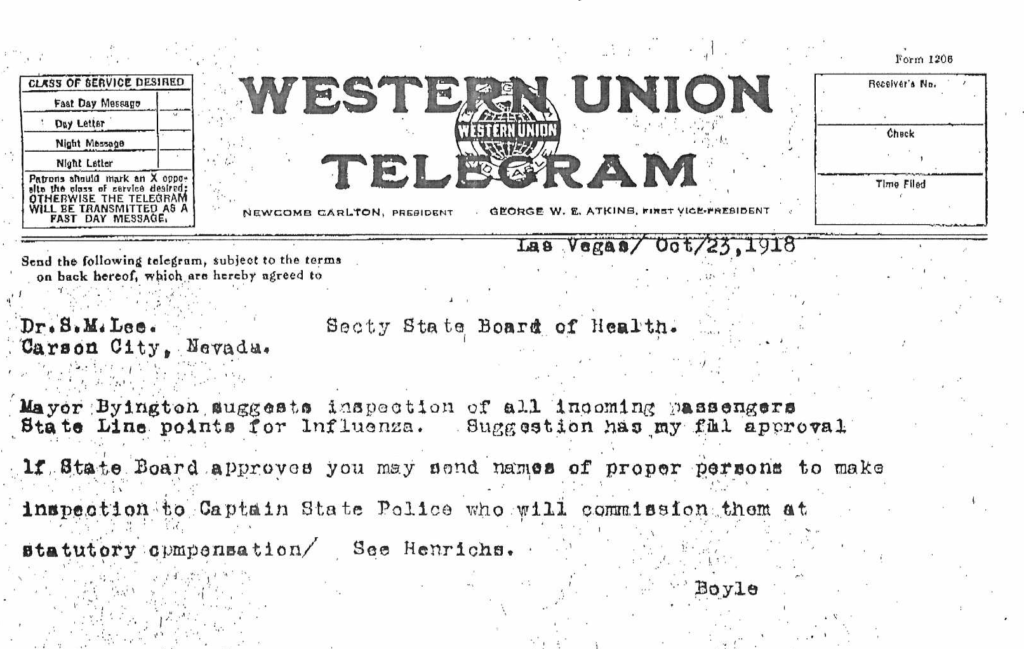
The governor sent his next telegram to the head of the state police, Captain R. B Henrichs.
Boyle instructed Henrichs to commission doctors and nurses, giving them authority to inspect passengers at the state line and take all necessary precautionary steps to stop the flu from entering Nevada.
Several hours later, Henrichs telegraphed the governor in Las Vegas to say that state police were moving forward and the “matter has been taken up with California and Utah health boards.”
“Nevada in Quarantine” was soon announced by the Salt Lake Tribune.
The newspaper reported that Gov. Boyle had issued a “proclamation” that “all passenger trains entering the state will be inspected at the state line and passengers intending to alight in Nevada will be carefully examined. If found to be infected with Influenza, they will be dismounted and quarantined at once.”
Similar stories were published in Southern California newspapers.
While Reno would report that several passengers passing through had the flu, there were no reports of any sick passengers being taken off the trains in Las Vegas.
At the same time Boyle was sending his telegrams, the Clark County Draft board was holding a mandatory meeting at the courthouse.
All draft-eligible men were required to attend. Dozens showed up and jammed into the little courtroom.
As names were being announced, Dr. Martin jumped up and ordered everybody out. He said it was not advisable to have that many people in a small, crowded room.
Most of those in the room who had complained of poor air circulation, were pleased with Dr. Martin’s action, including one man who let out a loud “A-men.”
That afternoon, after granting the state health board emergency powers, the governor departed on one of the last trains to run from Las Vegas to central Nevada. The governor had, in the end, been unsuccessful in saving the railroad. (When the tracks were removed, the roadbed later turned into what is now U.S. Highway 95.)
Arriving back in the state capitol, the governor was greeted by the newspaper headline, “Influenza holding Carson City in Its Grip.”
Boyle soon learned that the wife and son of former Nevada Gov. Denver Dickerson were among the influenza patients.
By the end of October, William Ferron, owner and manager of the city’s largest drug store, was hit with the flu.
Then the community learned the flu had begun to spread beyond the city limits. Dr. Martin discovered this was so when, on Saturday, Nov. 2, he visited Goodsprings. He found several cases of influenza in the remote desert hamlet and at the nearby Yellow Pine Mine.
First reports said the cases were not of “a serious nature.”
That would quickly prove to be wrong.
On Monday, November 4, the Las Vegas City Commission met in an emergency session at 8 a.m.
Only one item was on the agenda: “Establishing regulations to prevent the introduction and spread of Spanish Influenza or La Grippe into or within said City of Las Vegas.”
The mayor, William Hawkins, and all four members of the city commission attended.
They adopted Las Vegas City Ordinance number 73 – which required the wearing of face masks — “to prevent the introduction and spread of Spanish Influenza or La Grippe into or with said City of Las Vegas.”
The vote was unanimous. Within days of the meeting, both the mayor and Commissioner Bill Elwell became critically ill with the flu.
The commissioners also ordered that signs be printed and posted throughout the city detailing, among other requirements, how masks should be made and the penalties for not wearing one.
The ordinance went into effect less than two hours after the meeting. At 10 a.m., it was mandatory for everyone within the city limits to “at all times and all places wear upon the face a mask.”
Immediately following passage of the ordinance, every available Red Cross worker began making masks for everyone in Las Vegas.
According to the new ordinance, “Masks shall consist of four thickness of gauze material, five inches wide by eight inches long, with an eight inch tape attached to each corner, and shall be worn fitted firmly to the base so that the nose and mouth are at all times fully covered by said masks.”
By nightfall, anybody in Las Vegas who wanted a mask had one. Through the week, the Red Cross continued to provide the community with masks.
Signs were quickly printed and posted along Fremont Street announcing the new mask ordinance, which included the instruction that “each person wearing such mask shall sterilize the same at least once every four hours.”
The city called on “every member of the police force, every special officer, and every peace officer” to enforce the ordinance, which carried a fine of from $5 to $100.
From Reno to Elko to Goldfield, mask ordinances were being enacted around the state. Nevada’s counties and towns were enacting and strictly enforcing mask laws in November of 1918.
Arrests, fines and jail time were the orders of the day.
Fourteen men appeared in court November 9 in Elko for failing to wear masks. At the end of the day, one was “turned loose,” several were fined $5, and another went to jail.
A November 16 editorial in the Goldfield News and Tribune went further, in a rough-and-tumble tone.
The editorial, titled “Some Criminal Carelessness,” said, “While you are observing the mask law just keep in mind that you have a right to demand that others observe it. And don’t be afraid to assert your right. The individual who hasn’t respect enough for others... Don’t be afraid of hurting them.”
In Las Vegas, four men were arrested, and on Friday, November 8, were taken to court for failure to wear their masks. Following a stern admonishment, the city judge let them off without a fine.
Jail was not an option because all the cells were occupied. The reason: The state prison had banned Nevada counties and cities from sending convicted inmates to Carson City during the epidemic to ensure it had fewer cases of the Spanish Flu.
Bob Stoldal is a Las Vegas journalist and historian who now serves as chairman of the board of The Nevada Independent. He also is chairman of the board for the Nevada State Museum and Historical Society and a member of the City of Las Vegas Historic Preservation Commission. He also sits on the board of Preserve Nevada.
